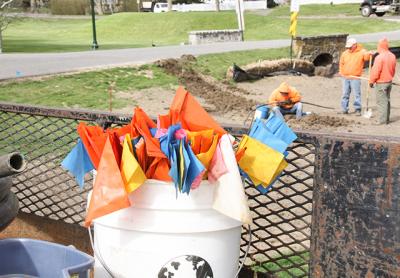To Follow Nature on Green

A project started last fall to improve the water quality of Town and Hook Ponds in East Hampton should be expanded slightly, not only to be more effective but to set an example for residential property owners, a landscape architect told the East Hampton Village Board on Friday.
The construction of bioswales — drainage courses designed to trap pollutants and silt from surface runoff on the green to the north of Town Pond — “had some pitfalls,” Tony Piazza of the Southampton landscape and garden design firm Piazza Horticultural told the board. Approximately a quarter of an acre on the green was excavated, and the changes in grade created ponding in some places. That, he said, was normal: “Sometimes the land and the terrain tells you how it has to be handled, rather than an engineer telling it how it has to be handled.”
Following the installation of wick drains, excessive water on the green drains within four hours, Mr. Piazza said. The next phase of the project, planting, is the aspect that should be expanded, he said. The original plan calls for three planting areas: next to the flagpole, across James Lane from St. Luke’s Episcopal Church, and next to the bridge on Mill Lane.
Stephen Mahoney of Mahoney Farm and Nursery in East Hampton accompanied Mr. Piazza. Both are members of the Surfrider Foundation, a nonprofit organization dedicated to protecting oceans and beaches, and a partner, with the village and the Ladies Village Improvement Society, in the project.
“We’re here to ask the board to consider us to do additional planting above and beyond what we had originally proposed,” Mr. Piazza said, chiefly to “connect the dots” by planting a 6 to 12-foot-wide “ribbon” between the bioswales at the flagpole and across from the church. This, he said, would be a natural line of plants, “as it would occur in nature in a wet area, to better capture that water as it moves and filter it even more as it goes through the process.”
Such extensive planting on the grassy spread of the village green may seem radical, he allowed, but it could “set an example to the homeowners that large, green expanses of lawn are not necessarily the best thing for everyone.” Runoff from fertilized residential lawns contributes to water bodies’ ailments, such as harmful algal blooms. “It could be a good message to send and a good aesthetic for people to get used to,” he said, “that the green carpet isn’t always the most beautiful thing.”
The planting connecting the two rain gardens “should look like nature put it there . . . following the meandering path that the water created,” Mr. Piazza said. He proposed Iris versicolor, or blue flag, a native iris that grows in wetlands, as well as Hibiscus moscheutos, a native mallow, and a native grass. At their tallest, the plants would rise to three feet, he said.
The additional work would come at no expense to the village, as the Surfrider Foundation has raised more than needed for the project as initially envisioned. Mr. Piazza said he hoped planting could begin next week.
Mayor Paul F. Rickenbach Jr. asked Mr. Piazza to stake out the proposed planting and put his proposal in writing ahead of the board’s next work session, next Thursday.
